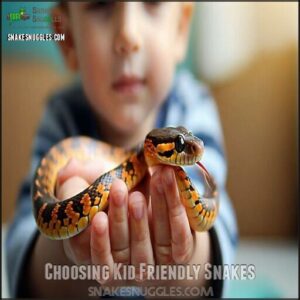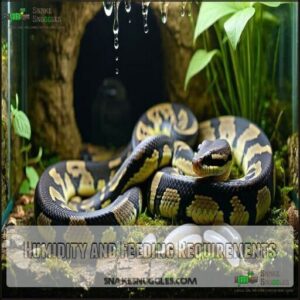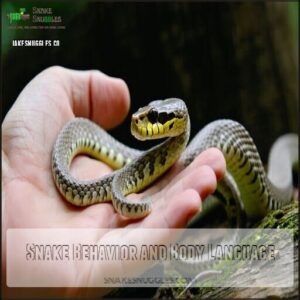This site is supported by our readers. We may earn a commission, at no cost to you, if you purchase through links.
 If you’re after the best snake species for kids, consider corn snakes, garter snakes, or ball pythons.
If you’re after the best snake species for kids, consider corn snakes, garter snakes, or ball pythons.
These snakes are calm, hardy, and easy to care for, making them great for young, first-time snake owners.
Corn snakes are gentle and come in stunning colors. Garter snakes are small and active, adding a bit of excitement without being overwhelming. Ball pythons, true to their name, curl up when hesitant, making handling stress-free.
Their care needs are simple—just the right habitat, warmth, and food.
Choosing the right snake guarantees both fun and safety, helping kids learn responsibility while bonding with their slithery friend.
Table Of Contents
- Key Takeaways
- Choosing Kid Friendly Snakes
- Snake Care Requirements
- Safety Considerations
- Frequently Asked Questions (FAQs)
- What is the best snake to own with kids?
- What is the friendliest snake for kids?
- What is the most beginner friendly snake?
- Do snakes make good pets for kids?
- How to properly clean a snake enclosure?
- What do snakes do during shedding?
- Are there hypoallergenic snakes for kids?
- How to identify a snake’s gender?
- Do pet snakes emit strong odors?
- Conclusion
Key Takeaways
- Choose beginner-friendly snakes like corn snakes, garter snakes, or ball pythons for their calm temperaments and easy care needs.
- Keep the snake’s habitat clean and at the right temperature and humidity to ensure good health and stress-free handling.
- Supervise kids when handling snakes and teach them to recognize calm versus defensive behavior to avoid bites.
- Provide a proper enclosure with secure lids, hiding spots, and the right size to meet your snake’s species-specific needs.
Choosing Kid Friendly Snakes
When choosing a snake for your child, focus on species that are gentle and easy to handle.
They should also have simple care needs, which makes them ideal for children. Popular options like corn snakes, ball pythons, and garter snakes offer a great balance of friendliness and low-maintenance care.
Corn Snake Characteristics
Corn snakes are perfect for kids, thanks to their calm temperament.
Corn snakes are kid-friendly, easy to care for, and ideal beginner pets with stunning colors and a calm nature.
These snakes are manageable in size, growing 3-6 feet long, with beautiful color variations like orange, red, and black.
Easy to handle and care for, they live up to 20 years in captivity.
- Docile nature, ideal for beginners
- Striking “Flint corn” belly markings
- Long lifespan expectations
Garter Snake Temperament
Garter snakes are an active, children-friendly option with manageable care requirements.
Garter snakes are lively and curious, making them a fun, interactive choice for kids who want an active pet.
While not all are docile snakes, frequent handling helps reduce their skittishness and bite potential.
Be ready for occasional musk production when startled—it’s their quirky defense.
With their adaptable snake temperament and lively activity levels, a garter snake pet can make a fascinating companion for kids learning responsibility.
They also use pheromone signals and trails to communicate.
Ball Python Handling
Ball pythons are fantastic for kids due to their calm temperament, but handling them requires care. Always supervise children when handling snakes to guarantee safety.
Here are tips for smooth handling:
- Handle 1-2 times weekly to minimize temperament changes.
- Maintain a secure grip without squeezing.
- Avoid handling during shedding or after feeding.
- Watch for bite risk signals like hissing or “S” shapes.
To prevent accidental bites, it’s important to practice proper hand hygiene.
Snake Care Requirements
You’ll need to provide your pet snake with the right heating, lighting, and humidity to keep it healthy and comfortable.
It’s also important to choose an enclosure that’s the appropriate size and include essentials like hiding spots and a secure lid.
Heating and Lighting Needs
To keep your snake healthy, maintain a proper temperature gradient in its enclosure.
Use a basking heat source for daytime warmth and guarantee a nighttime heat reduction.
UVB lighting isn’t always necessary but consult species requirements.
Monitor snake heating with thermometers to avoid overheating.
Proper snake enclosure lighting boosts activity and mimics natural day-night cycles—keeping your pet happy!
Many owners utilize a pad for warmth. Proper snake enclosure lighting
Humidity and Feeding Requirements
Balancing snake humidity and diet is critical.
Aim for shedding humidity during molting; a mist or humid hide helps.
Feeding frequency varies—most eat weekly.
Match prey size to the snake’s body width, avoiding choking risks.
Guarantee fresh, ample water access for digestion.
Digital hygrometers help monitor levels.
Snake feeding thrives with variety; use supplementation needs sparingly for species requiring specific nutrients.
Habitat and Enclosure Size
When creating a snake habitat, focus on the right tank dimensions for your chosen species.
Smaller snakes, like garter snakes, thrive in 10-20 gallon enclosures, while corn or ball pythons need 40-50 gallons.
Include safe substrate types, cozy hiding spots, and enrichment items like branches or tunnels.
Consider garter snake enclosures for these smaller species.
Clean the snake enclosure weekly to maintain proper humidity and temperature.
Safety Considerations
When choosing a pet snake for kids, safety should always come first.
Understanding their behavior, proper handling techniques, and common health risks helps prevent accidents and keeps both the snake and your child safe.
Snake Behavior and Body Language
Understanding snake behavior helps keep interactions safe. Look for these cues:
- Defensive Postures: A coiled body or hissing means back off gently, as the snake feels threatened.
- Shedding Signs: Dull scales and cloudy eyes signal shedding; avoid handling during this time.
- Eating Habits: Reduced feeding may indicate stress or illness.
- Social Behavior: Docile snakes usually tolerate calm handling; watch for stress signs.
Handling and Safety Precautions
When handling snakes, always supervise children and follow safe handling techniques.
Use slow movements to avoid startling the snake, and support its body fully to prevent escape risks.
Teach kids to recognize calm versus defensive behavior to avoid bites.
Encourage hygiene practices, like washing hands after handling, to stay safe.
These simple snake handling tips guarantee a positive experience!
Common Health Issues in Pet Snakes
Snakes can face common health concerns like respiratory infections, mouth rot, scale rot, and parasites such as mites.
Obesity also leads to problems if overfed.
You’d notice signs like wheezing, swollen mouths, or lethargy.
Keep their habitat clean and at the right temperature to prevent snake fungal infections and respiratory issues—healthy living means a happy, slithering companion!
Anorexia can also be a concern, potentially indicating underlying parasitic infestations.
Frequently Asked Questions (FAQs)
What is the best snake to own with kids?
A Corn Snake is like the golden retriever of pet snakes—calm, gentle, and great with kids.
With easy care, a docile nature, and manageable size, it’s the perfect reptile companion for young snake enthusiasts.
What is the friendliest snake for kids?
For kids, a Corn Snake is a top choice.
It’s gentle, easy to handle, and rarely bites.
They’re colorful, manageable in size, and low-maintenance—perfect for young beginners exploring the joys of snake care.
What is the most beginner friendly snake?
Starting with snakes can feel like dipping your toes into mystery, but a Corn Snake’s gentle nature, striking colors, and low maintenance make it perfect for beginners.
They’re easy to care for and rarely bite!
Do snakes make good pets for kids?
If you want a low-maintenance, fascinating pet, snakes can be great for kids.
They’re quiet, don’t need daily attention, and teach responsibility.
Just make certain you choose a beginner-friendly species with gentle handling habits.
How to properly clean a snake enclosure?
To clean a snake enclosure, remove the snake, discard soiled bedding, and scrub surfaces with reptile-safe cleaner.
Rinse thoroughly, replace substrate, and sanitize water dishes.
Regular cleaning keeps your snake healthy and happy!
What do snakes do during shedding?
Shedding signals snakes embracing change!
During this process, their old skin loosens, scales turn dull, and cloudy eyes appear.
Snakes retreat, rub against surfaces to peel, and emerge vibrant—like slipping out of yesterday’s clothes!
Are there hypoallergenic snakes for kids?
Snakes aren’t hypoallergenic, but species like Corn Snakes and Ball Pythons produce minimal allergens.
Their dry scales don’t shed dander like pets with fur, making them a better choice for allergy-sensitive kids.
How to identify a snake’s gender?
To identify a snake’s gender, look at the tail length and thickness near the vent—males have longer, thicker tails.
Using a probe by a reptile expert provides the most accurate result.
Do pet snakes emit strong odors?
You might think a pet snake would stink up the place, but most snakes don’t emit strong odors.
Keep their enclosure clean, and you’ll barely notice a smell.
It’s easier than maintaining a dog!
Conclusion
Did you know pet snakes can live up to 20 years with proper care?
Choosing the best snake species for kids, like corn snakes, garter snakes, or ball pythons, guarantees a safe, enjoyable experience.
These snakes are friendly, easy to handle, and require low-maintenance setups. Teach your kids responsibility while they bond with these fascinating reptiles.
With the right knowledge about their habitat, diet, and behavior, owning a pet snake can be both rewarding and educational.
- https://vcahospitals.com/know-your-pet/snakes-owning
- https://www.reptilesmagazine.com/5-great-beginner-pet-snakes/
- https://reptifiles.com/ball-python-care-guide/ball-python-handling-tips/
- https://community.morphmarket.com/t/to-handle-or-not-to-handle-that-is-the-question/42388
- https://www.reddit.com/r/ballpython/comments/shz11z/how_do_you_get_a_snake_used_to_being_handled_more/













